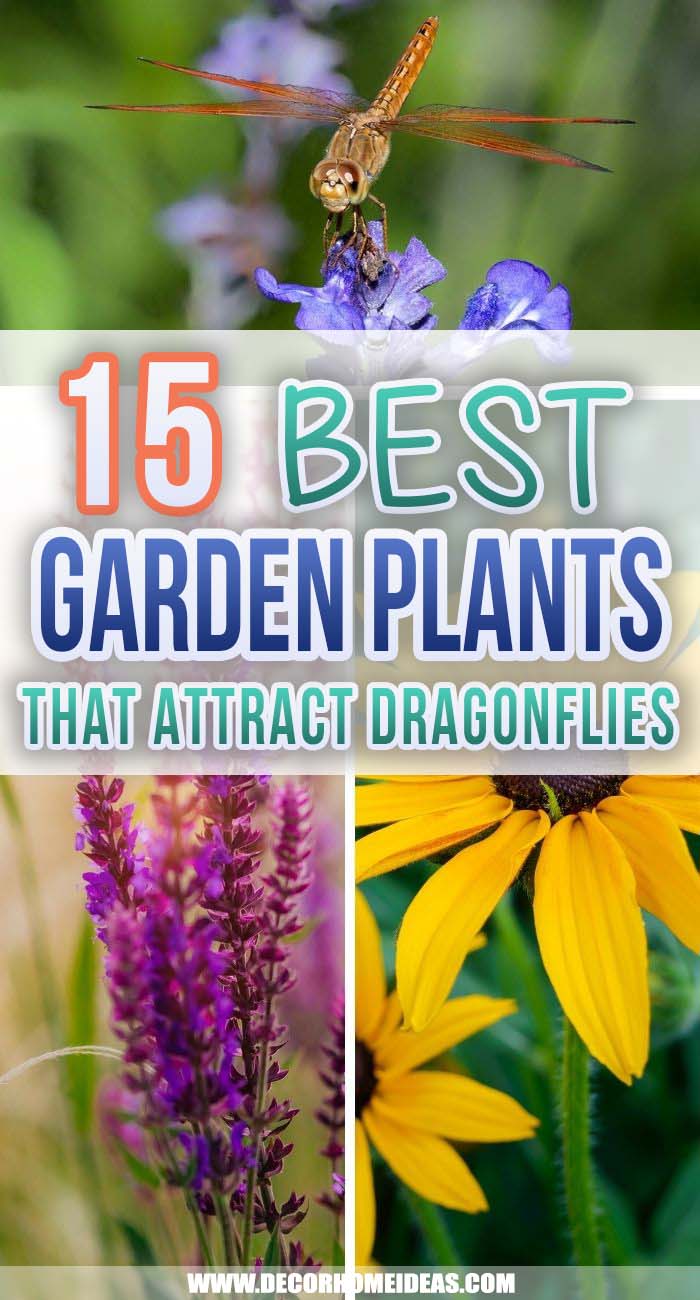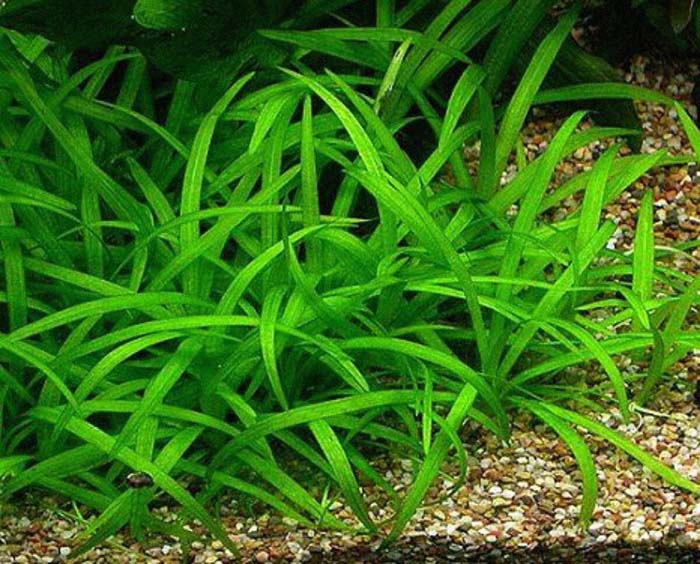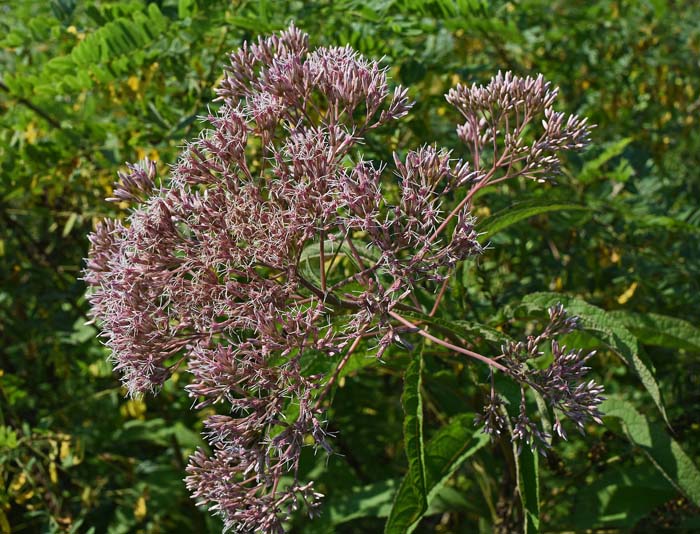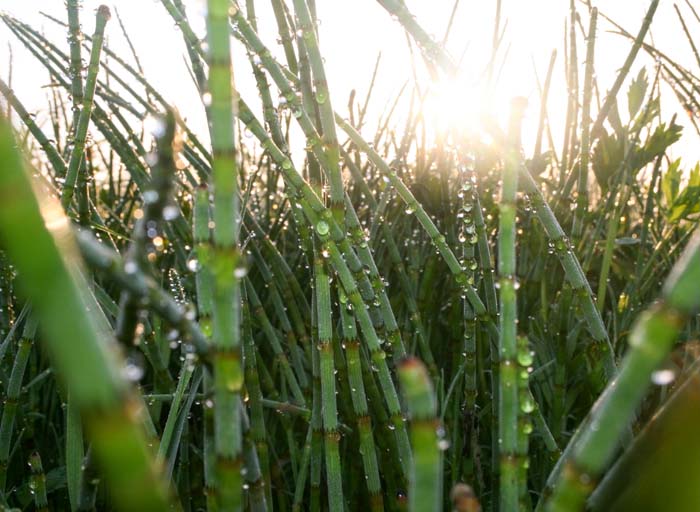With their colorful bodies and dramatic aerobatic moves, dragonflies are a lovely addition to any garden.
They’re beautiful, but they’re also incredibly helpful — these predatory, carnivorous insects eat a wide range of garden pests, including mosquitoes.
As you’re planning the upcoming season, add in some of the plants that attract dragonflies; they’ll turn your yard into a spectacular, mosquito-free zone.

We have also prepared a selection of mosquito repelling plants for you:
20 Best Mosquito Repelling Plants To Grow And Enjoy More The Time Outdoors
The easiest way to attract dragonflies is to make a dragonfly birdbath or get one from here. Dragonfly pond will make a natural habitat for the dragonfly larvae to be taken care of. Just add some of the pond plants and surround it with blooming flowers from the selection below.
Plants That Attract Dragonflies
1. Arrowhead

Botanical name: Sagittaria latifolia
If you’re wondering what plants attract dragonflies to a water feature, look no further than the arrowhead.
This aquatic species grows roots under the surface of your pond or pool; the stems and leaves grow above the water, creating plenty of space for dragonflies to rest.
The large, arrow-shaped leaves add a splash of bright color to your garden, and the delicate white flowers bring the yard to life every spring.
Don’t worry if you live in a climate with cold winters — the arrowhead is hardy and versatile, so it can survive a wide range of conditions.
2. Black-Eyed Susan

Botanical name: Rudbeckia hirta
You’ve probably seen the bright yellow black-eyed Susan flowers, but did you know that they’re a favorite among dragonflies?
The secret is the lush green foliage and the large flowers — dragonflies will fly into the leaves to lay their eggs and take care of nymphs.
When the new insects are full-grown, your garden will come to life. Black-eyed Susans are exceptionally hardy; they’re particularly well-suited to areas with cold winters. If possible, choose a spot with lots of direct sunlight.
3. Borage

Botanical name: Borago Officinalis
If you live in a dry or cold area, check out the hardy borage plant. It grows quickly and stands up well to ultra-dry conditions, making it a convenient way to attract dragonflies in tough climates.
In fact, this lovely plant grows easily in zones 2-11. When it’s full-grown, the borage produces stunning bright-blue flowers with pointed petals.
The stems are covered in a delicate, feathery coating that’s appealing to dragonflies. You can even use the leaves of this herb to flavor your summer dishes.
4. Cattail

Botanical name: Typha latifolia
If you have a large pond on your property, cattails are a great way to deter mosquitoes and encourage dragonflies.
Tall and lush, these plants create a beautiful border along the edge of the water.
Some varieties can grow to be 10 feet tall! The towering leaves give dragonflies lots of places to hide, so they’re more likely to stick around. Cattails thrive in humid, sunny spots, but they grow everywhere from zone 3 to zone 10.
5. Dwarf Sagittaria

Botanical name: Sagittaria subulata pusilla
When you have a tiny water feature, you need proportionally sized water plants.
That’s where the dwarf Sagittaria comes in. This miniature, grass-like plant tops out at just 6 inches tall, so it’s perfect for little ponds or manmade pools.
Dragonflies love to take shelter under the curving blades — you can expect to see them buzzing around your garden in no time. Plant this bright green foliage wherever you want to repel mosquitoes.
6. Fanwort

Botanical name: Cabomba caroliniana
With its feathery green foliage, the fanwort plant is a stunning way to attract dragonflies to your yard.
The insects like to lay their eggs on the bottom of each leaf, creating a safe place for the young dragonflies to hatch.
Fanwort is aquatic, so most of the foliage grows underwater; on the surface, it grows lovely flowers that accent the surface of your pond. As it is a submerged plant you do need some kind of backyard pond.
This is a great way to enjoy a water feature without the hassle of mosquitoes.
7. Giant Coneflower

Botanical name: Rudbeckia maxima
As soon as you see the giant coneflower, you’ll understand how it got its name; each flower features a tall, cone-shaped center.
The blooms can reach 6 inches across, giving your yard a bold, showy look. Choose a planting spot with lots of sunshine, and it will grow quickly.
Dragonflies love to rest on the centers, so you don’t need to worry about mosquitoes – that’s what I call a beneficial insect!
8. Joe-Pye Weed

Botanical name: Eupatorium purpureum
Joe-Pye weed goes by many other names, including kidney root and trumpet weed.
No matter what you call it, this gorgeous flower is an ideal way to bring more dragonflies to your yard. About halfway through the summer, the plants sprout large clusters of light-purple flowers.
Give these plants lots of space — they can grow up to 12 feet tall. As long as you plant them in a spot with plenty of drainage, these dragonfly-attracting flowers are a low-maintenance option.
9. Meadow Sage

Botanical name: Salvia pratensis
Create a natural, wildflower-style garden by planting meadow sage.
Each year, tall spikes of purple flowers rise high above the bright green leaves. Dragonflies love to hang out nearby, soaring among the leaves and hiding out under the stems.
They’re also a great choice if you’re trying to keep deer from eating your fruits and vegetables; the natural substances in meadow sage repel garden pests.
Plant these flowers in a bright, sunny spot for best results.
10. Swamp Milkweed

Botanical name: Asclepias incarnate
Are you looking for a way to fill the space in a large yard or garden?
The Swamp milkweed is an excellent option. In just one season, each plant will grow to be about 3 feet wide.
Don’t let the name deter you — each year, the swamp milkweed produces enormous clumps of delicate flowers that add a splash of color to your garden. In addition to attracting dragonflies, this plant encourages butterflies to visit your yard.
11. Sweet Coneflower

Botanical name: Rudbeckia subtomentosa
Do you live in zones 4-8? Add the sweet coneflower to your spring planting schedule, and your garden will be alive with dragonflies in no time.
The brilliant yellow petals contrast beautifully with the dark centers, creating an eye-catching twist. Use it around the edges of the garden, and you won’t need to worry about deer; they don’t like this sun-loving flower.
12. Water Horsetail

Botanical name: Equisetum fluviatile
The best way to attract dragonflies is to create space for egg-laying.
That’s where the water horsetail comes in. It grows in tall, slim stalks that look a little bit like miniature bamboo plants.
Simply plant it in your pond, and wait for the green shoots to appear above the surface. In zones 4-11, the water horsetail can reach 3 feet tall.
13. Water Lily

Botanical name: Nymphaeaceae
The water lily is one of the most beautiful aquatic plants you can find.
There’s a reason it’s a favorite among gardeners — the flowers feature thick, layered petals resting on large, round leaves.
Dragonflies love to lay their eggs on these stunning plants; when they hatch, the insects keep mosquitoes away from your yard. Dragonflies love all types of pond plants.
If you don’t have a pond, you can also grow water lilies in a hybrid soil/water container system.
14. Wild Celery

Botanical name: Vallisneria Americana
When you’re figuring out how to attract dragonflies to your garden, it’s important to create shelter.
That’s where wild celery comes in — it produces lots of long, skinny leaves, creating plenty of places for dragonflies to lay their eggs and nurture their young.
Make your life easier by purchasing large wild celery plants from a nursery; you can transplant them in a water feature and start attracting dragonflies right away. The stems are relatively hardy, so they thrive in a range of conditions.
15. Yarrow

Botanical name: Achillea millefolium
Bring color and dragonflies to your garden by planting yarrow. It’s a low-maintenance choice — you can start it from seed or transplant fully-grown plants. In sunny spots, the stems will grow easily.
Each summer, this hardy plant rewards your work with brilliant pink properties. If you have a small yard, it’s a good idea to cut it back every so often to prevent it from taking over your space.









